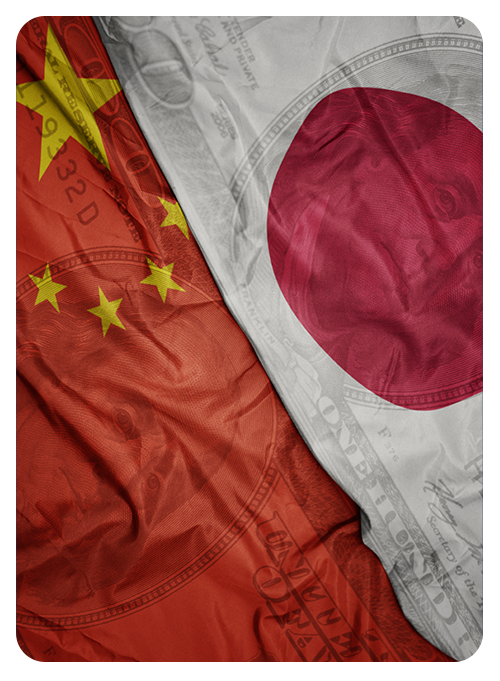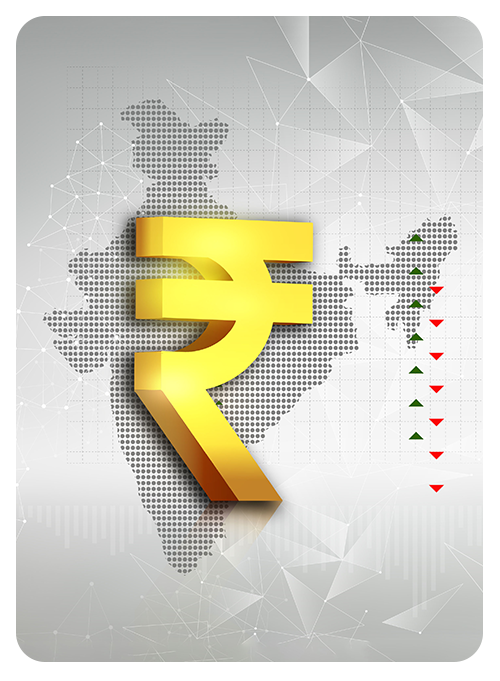Finsphere
From Wall Street to Dalal Street:
What Global Shifts Mean for India?

Dear Clients and Stakeholders,
Investors are embracing evolving ‘New World Order’ positively, with the hope that despite economic power and trade polarization challenges; world economy will find its way. US equity markets scaled new heights as economic data points pointed to strong underlying fundamentals. GDP growth for Q2 came at 3.30% (annualized) higher than expectation of 3.0% while quarterly earnings majorly were a beat on estimates. Further investors drew optimism from FED Chairman signals that the interest rate cut may happen as early as September. In line follow up came from European markets and Asian majors namely, China and Japan. The month gone by The MSCI All-Country World Index rose 2.5%. Yet, behind the headline gains, the month revealed important shifts: labour markets in the United States cooled further, inflation showed signs of stickiness in core services, and politics intruded into the economic narrative.
The US remained the focal point, with weaker payrolls and falling job openings prompting a recalibration of monetary policy expectations. Chair Powell’s speech at Jackson Hole framed the risks more evenly, reinforcing the case for a near-term cut. At the same time, President Trump’s tariff escalations - including raising duties on Indian exports to 50% - and his attempt to dismiss a Federal Reserve governor reignited debates around global trade and central-bank independence.
In Europe, sentiment stabilized as PMIs returned to expansion territory, though French political uncertainty and the UK’s inflation pressures tempered the outlook. Japan posted better-than-expected GDP growth, while China showed modest improvement in activity alongside targeted policy support, even as property and external demand remained headwinds.
For India, the domestic story stayed resilient. GDP grew 7.8% year-on-year in Q1FY26, GST collections touched record levels, and inflation continued to ease, supporting the Reserve Bank’s earlier rate cut. However, the imposition of higher US tariffs added a new dimension to the external environment, underscoring how global politics can directly shape the opportunity set for domestic corporates. Expected roll out of GST 2.0, by 22nd of September is likely to mitigate high tariffs being imposed by US administration on Indian imports.
As we move towards the final quarter of 2025, markets find themselves balancing disinflation and policy easing against geopolitics and late-cycle signals. This newsletter unpacks these dynamics region by region—beginning with the United States, the key anchor for global risk sentiment.
United States
Resilient Growth, Cooling Labour, Shifting Policy
August in the United States highlighted how solid growth can coexist with signs of cooling in employment and spending, forcing policymakers and investors to recalibrate. The second estimate of GDP confirmed a 3.3% annualised expansion in Q2, revised up from 3.0%, and a rebound from the contraction of 0.5% in Q1; with business investment rising nearly 6% and consumer spending up 1.6%.
Labour market data, however, revealed a softer tone. Nonfarm payrolls increased by only 22,000, well below expectations, while job openings slipped to their lowest since 2024. The unemployment rate rose to 4.3%, its highest in almost four years, with participation ticking higher. Jobless claims edged up, suggesting some stress, but continuing claims fell to their lowest since March, pointing to gradual rather than abrupt cooling. This shift was reflected in confidence surveys: the University of Michigan’s consumer sentiment index dropped to a three-month low, while the Conference Board’s expectations index slipped below the threshold that has often preceded recessions.
Inflation progress was uneven. Headline CPI held at 2.7% y/y, but core inflation accelerated to 3.1%, the highest since early spring. The Fed’s preferred core PCE index rose 0.3% m/m, leaving the annualised pace at 2.9%. Producer prices jumped 0.9% m/m, the steepest gain since 2022, driven by services and energy inputs. Goods categories, such as gasoline and fuel oil, eased, but housing and transportation services kept inflation pressures elevated.

Activity indicators also sent mixed signals. Retail sales climbed 0.5% m/m, with strong auto sales but softer demand in discretionary categories. Industrial production fell 0.1%, pulled down by mining and utilities, while manufacturing output stabilised. The US trade deficit widened to $78.3 billion, it’s largest in four months, as imports surged nearly 6%, outpacing muted export growth. Durable goods orders dropped 2.8% m/m, extending earlier declines as firms adjusted supply chains to avoid tariffs.
Housing data reflected affordability pressures. Housing starts rose 5.2% m/m, their strongest pace in five months, but building permits fell 2.8%, signalling slower forward activity. Pending home sales and new home sales both softened, while the FHFA house price index edged down on the month but remained 2.6% higher y/y. Together, these figures suggest a housing market that remains constrained by costs and financing conditions, even as supply begins to adjust.
Financial markets largely looked through these mixed signals, focusing instead on the Fed. Chair Powell’s Jackson Hole remarks framed the risks as more balanced, paving the way for a 25 bps rate cut in September. Governor Waller supported this view, noting that labour risks now outweigh inflation risks. Treasury yields fell at the front end, the dollar softened, and gold firmed. Equities advanced across the board: the Dow gained 1.6%, the S&P 500 rose 2.0%, the Nasdaq added 2.4%, and the Russell 2000 outperformed with a 3.2% rise. Smaller companies were lifted by the prospect of easier financing, while mega-cap technology took a breather after months of outperformance. Nvidia’s earnings typified this shift: revenues rose 56% year-on-year, but the muted stock reaction showed that investor expectations are now harder to exceed.
Politics kept the month eventful. President Trump’s attempt to dismiss Fed Governor Lisa Cook sparked a legal battle over central-bank independence. On trade, the administration extended the US–China tariff truce into November but also raised tariffs on Indian goods to 50% and floated a 100% duty on imported semiconductors. The US also widened duties on steel, aluminium, and cars, fuelling uncertainty over global supply chains. Despite these developments, investors chose to anchor on the Fed’s dovish tilt, which carried more immediate weight for markets.
Taken together, August painted a picture of a US economy still growing at a healthy pace, but with clear signs of moderation in employment, housing, and manufacturing. Inflation progress remains incomplete, keeping services costs under scrutiny, while politics - from tariffs to Fed governance - adds further noise. Yet for markets, the dominant takeaway was that monetary easing is approaching, supporting risk appetite even as tariff policy frictions remain unresolved.

Eurozone & UK
Signs of Stabilisation Amid Political and Inflation Pressures
August brought some relief to Europe as activity indicators signalled that the slowdown may be bottoming, though political instability and sticky inflation prevented a more decisive recovery narrative. The Eurozone composite PMI rose to 51.1, its strongest level in over a year, with manufacturing returning to expansion for the first time since early 2022. Services activity slowed but remained marginally above 50, suggesting that while growth is stabilising, the pace remains modest. Hard data reinforced that caution: Q2 GDP for the Euro Area expanded just 0.1% q/q, reflecting weak household consumption and lacklustre external demand. Retail sales volumes fell 0.5% m/m in July, highlighting that household spending remains under pressure. On the price side, producer prices rose 0.8% m/m, pointing to renewed cost pressures, and the flash inflation print for August ticked up to 2.1%, with core steady at 2.3% - levels that still constrain the ECB’s room to pivot quickly.
Politics injected fresh volatility. In France, Prime Minister Bayrou faced a no-confidence vote scheduled for early September after failing to secure backing for budget reforms, underscoring persistent political fragility. This weighed on sentiment in French markets, with the CAC 40 declining ~0.8% in August. Germany, by contrast, showed some improvement in factory orders and capex indicators, but equities failed to be encouraged, with the DAX slipping ~0.7%, reflecting broader concerns over external demand and global trade.
The United Kingdom experienced a similar mix of stabilisation and constraint. Activity indicators held up, with the services PMI at 51.8 pointing to steady expansion and July retail sales rising 0.6% m/m. Yet inflation remained a challenge, with headline CPI re-accelerating to 3.8% y/y in July, well above target. Against this backdrop, the Bank of England cut Bank Rate by 25 bps to 4.0% in early August, its first reduction in this cycle, signalling a cautious tilt toward growth support while warning that price pressures remain elevated. Equities tracked global sentiment, with the FTSE 100 up ~0.6% in August, supported by defensive and energy-linked sectors that cushioned domestic concerns.
Overall, Europe and the UK offered a picture of fragile stabilisation: activity is improving at the margin, but demand remains weak, inflation progress incomplete, and political risks elevated. Market performance in August reflected this balance - modest regional gains in the Euro Stoxx 50 and FTSE, offset by declines in France and Germany - highlighting that investors remain wary until clearer evidence of a durable recovery emerges.
Asia
Divergent Growth Paths Under Tariff Pressures
Japan’s economy continued to expand in Q2, with GDP rising 0.3% q/q, the fifth consecutive quarter of growth and ahead of expectations. The rebound was supported by stronger business investment (+1.3%) and a positive contribution from trade as exporters front-loaded shipments ahead of US tariffs implementation. Private consumption held up modestly at 0.2%, while government spending was flat. Industrial production also gained traction in June, up 2.1% m/m, the strongest pace in four months, though July data showed a reversal with output down 1.6% m/m, reflecting the uneven nature of momentum.
The inflation picture moderated slightly. CPI eased to 3.1% in July, it’s lowest since November 2024, as electricity prices declined for the first time in over a year. However, food prices surged 7.6% y/y, with rice costs soaring more than 90%, highlighting the pressures households still face. Producer price inflation also slowed to 2.6% y/y, the lowest in a year. PMI data illustrated the external headwinds: manufacturing slipped to 49.7, its 13th contraction in 14 months, as foreign orders fell sharply amid US tariffs, while services activity remained resilient at 53.1, supported by domestic demand.

Japan’s external balances reflected these strains. The trade deficit narrowed to JPY 118 billion, down from over JPY 600 billion a year earlier, but exports fell 2.6% y/y, marking the sharpest drop since early 2021 as tariffs dampened demand. Imports also contracted, down 7.5%, reflecting weaker domestic purchasing power. Markets tracked these cross-currents: the Nikkei 225 ended August marginally higher (+0.2%), while the TOPIX slipped 0.8%, as investors weighed tariff headwinds and rising JGB yields near 17-year highs.
China, by contrast, showed a different balance of resilience and strain. Industrial production rose 5.7% y/y in July, slower than June’s 6.8%, while retail sales growth softened to 3.7% y/y, the weakest since December 2024, as consumer categories like autos and household goods faltered. The official manufacturing PMI improved to 50.5, returning to expansion territory, while the services PMI climbed to 53.0, its fastest pace since May 2024, pointing to firmer domestic demand. Still, employment pressures persisted, with manufacturers and service providers trimming staff to contain costs.
Trade remained a bright spot: China’s trade surplus widened to USD 98.2 billion, with exports up 7.2% y/y, helped by a temporary easing of tariff pressures under the extended US–China truce, while imports rose 4.1% y/y, beating expectations. The central bank maintained its one- and five-year loan prime rates at 3.0% and 3.5%, reinforcing a supportive stance, though there is an expectation of additional stimulus measures in the coming months given slowing domestic momentum.
Equity markets reflected investor optimism despite softer data. The CSI 300 surged ~10% in August, one of the best global performances, fuelled less by economic fundamentals than by liquidity-driven flows and record margin debt levels as households sought higher returns amid limited investment alternatives.
In summary, Japan showed steady but fragile growth, underpinned by capex and services resilience but constrained by tariffs and weak exports. China delivered stronger headline momentum in trade and PMIs, but domestic demand showed fatigue. Together, the region highlighted the extent to which global trade policy and domestic policy support are shaping the near-term trajectory for Asia’s two largest economies.

India’s Economic Pulse:
Domestic Resilience Meets External Headwinds
India entered August with depleting sentiments as the rolling in earnings for Q1FY26 were faring poor at mid-single digits, nervous management commentaries and rising external pressures, particularly from escalating US tariffs.
Though the macro-economic data painted a contrasting picture of resilience. GDP expanded 7.8% y/y in Q1FY26, the fastest in five quarters, well ahead of expectations. The services sector led the charge with growth of 9.3%, its best in two years, driven by transport, trade, and financial services, while government spending added further impetus with nearly double-digit expansion. Manufacturing output rose 7.7%, holding steady despite weaker global demand signals, while construction moderated to 7.6% after a strong run. Private consumption surged to a three-quarter high of 7%, supported by rural wage gains and stable food prices, lifting household spending to nearly 57% of GDP. Investment remained firm, with the investment-to-GDP ratio climbing to a three-year high of 34.6%.
Inflation underscored the benign environment for growth. CPI eased to 1.55% in July, the lowest since 2017 and below the RBI’s tolerance band for the first time since 2019, while WPI fell 0.58% y/y, dragged down by steep declines in vegetables and fuel. This gave the RBI space to consolidate after June’s 50 bps cut; it held the repo rate steady at 5.5% in August, revised down its FY26 inflation forecast to 3.1%, and reaffirmed growth at 6.5%. The central bank struck a balanced tone: pointing to benign price conditions and supportive monsoons on one hand, but flagging trade tensions with the US as a clear downside risk on the other.
High-frequency indicators reinforced the picture of domestic strength. The HSBC India Manufacturing PMI rose to 59.3, the strongest in nearly 18 years, with new orders climbing at the fastest pace in almost five years. The Services PMI surged to 65.6, a record high, highlighting buoyant demand in both domestic and export-facing segments. Industrial production accelerated to 3.5% in July, and core sector output rose 2%, supported by steel and cement, even as coal and oil output contracted. Unemployment fell to 5.2%, aided by improved labour participation in rural areas.
Despite this strong domestic base, external vulnerabilities deepened. The merchandise trade deficit widened to $27.4 bn in July, the largest in nine months, as exports slowed ahead of tariff deadlines and imports stayed elevated. On August 27, the US administration doubled duties on Indian exports to 50%, targeting sectors from textiles to metals. While pharmaceuticals were spared immediate duties, the impact on labour-intensive industries such as textiles and autos is expected to be significant. Still, India’s external position remained buffered: the current account deficit narrowed sharply to $2.4 bn in Q1FY26 (0.2% of GDP) thanks to rising services exports and record remittances, while FX reserves stayed elevated at $694 bn by end-August.
Corporate earnings reflected this duality. Q1FY26 profits of Nifty 50 companies grew 5.4% y/y, but contracted 17.6% sequentially, as management commentaries flagged uncertainty around demand and tariffs. Excluding exceptional items — Reliance’s one-off stake sale in Asian Paints and HDFC Bank’s partial listing of HDB Financial — earnings growth was in mid-single digits. Cement, autos, healthcare, and capital goods reported healthy operating profit growth, while IT services, FMCG, and banking posted subdued results. Banks, however, booked treasury gains after the June rate cut, cushioning weaker loan growth.
On the fiscal side, the government faced tighter balances. The fiscal deficit widened to ₹4.68 lakh crore in April–July, nearly 30% of the annual estimate, as expenditure outpaced receipts. Direct tax collections fell 4% y/y due to higher refunds, though GST collections rose 6.5% y/y to ₹1.86 lakh crore in August, marking the second-highest monthly tally ever. Crucially, the GST Council approved a simplified dual rate structure of 5% and 18% effective September, setting the stage for GST 2.0 reforms ahead of Diwali.
Markets navigated this backdrop with caution. Foreign institutional investors were net sellers after inflows earlier in the year, while domestic institutions and mutual funds continued to provide support.
Geopolitics provided both challenges and opportunities. Trade negotiations with the US stalled, while New Delhi launched outreach to diversify exports across 40 countries, particularly in textiles. Prime Minister Modi’s bilateral with President Xi Jinping in Tianjin signaled a thaw in relations, with both sides agreeing to resume flights, reopen border trade, and expand investment flows. Meanwhile, S&P upgraded India’s sovereign rating to BBB (stable), citing fiscal consolidation and structural growth drivers, lending credibility to India’s macro story despite global uncertainty.
Conclusion
We expect optimism to prevail in coming months on back drop of investor attention being focused on: the US Federal Reserve’s policy path, political developments in Europe and the resilience of Asian economies under trade frictions. For India, the rollout of GST reforms, evolving trade dynamics, and the trajectory of corporate earnings will be key.
I would like to extend my sincere gratitude for your continued trust and support. It is your confidence that allows us to serve as a partner in navigating complex markets and identifying opportunities amidst uncertainty. We remain committed to providing you with clear analysis, timely insights, and thoughtful guidance to help you make informed decisions in an ever-changing environment.
Warm Regards,
N Senthilkumarh
President and CBO
Chola Securities
